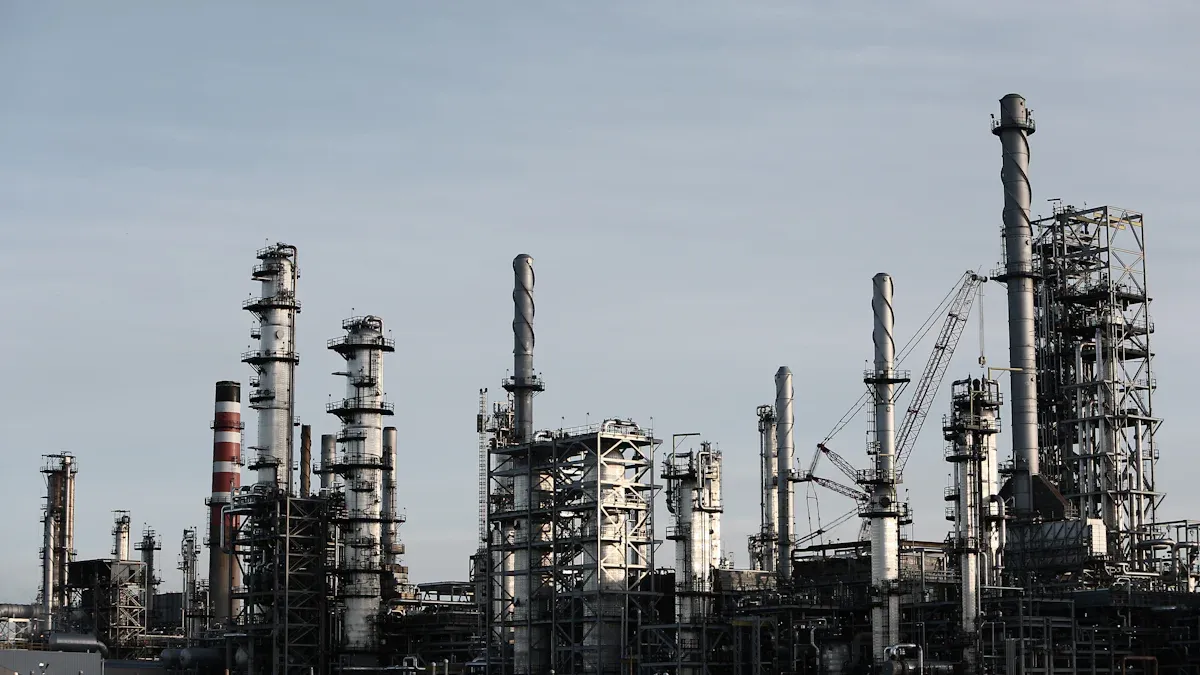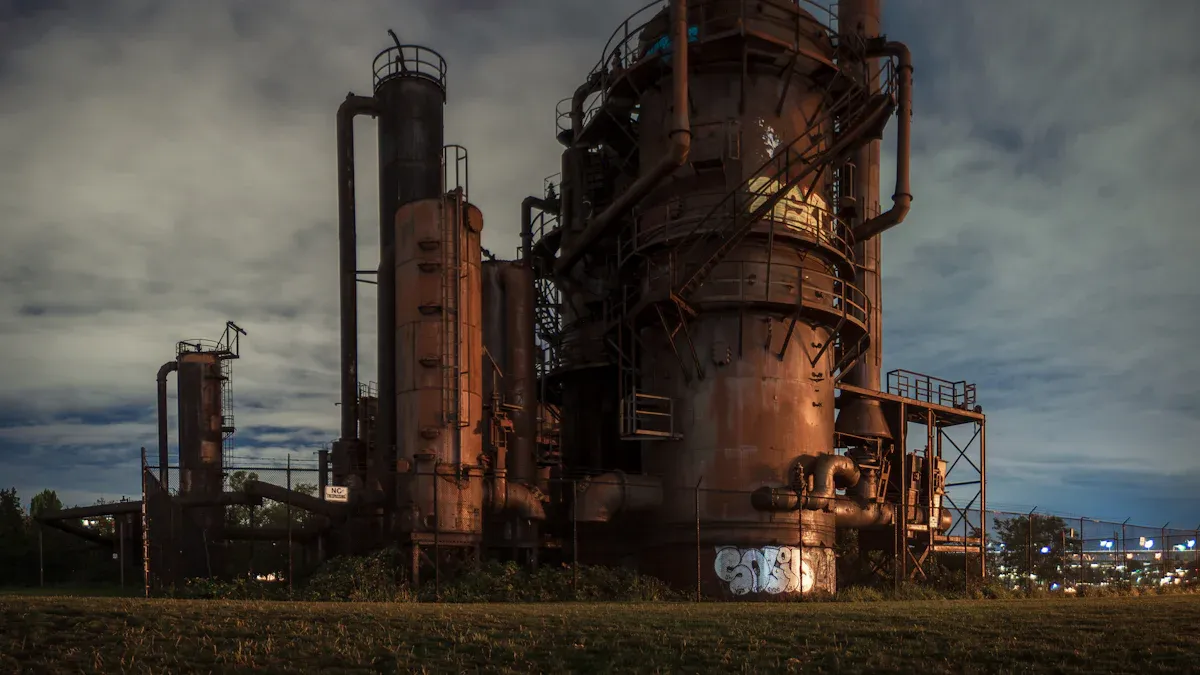How Nitrogen Gas Generators Function in Industrial Applications

Nitrogen gas generators play a vital role in producing nitrogen through specialized processes. These systems effectively separate nitrogen from compressed air, making them essential for various industrial applications. For instance, the PSA nitrogen generator market has grown significantly due to its ability to replace traditional nitrogen supply methods. Users gain greater control over their nitrogen supply while enjoying reduced operational costs. Understanding how nitrogen generators work can enhance your operations and improve efficiency in your industry.
Key Takeaways
Nitrogen gas generators are a cheap way to make nitrogen on-site. They can cut costs by 50% to 70% compared to older methods.
Pressure Swing Adsorption (PSA) systems give very pure nitrogen, often over 99.9%. This makes them great for industries that need high quality.
Membrane separation technology is easier and smaller. It works well for smaller uses while still making reliable nitrogen.
Making nitrogen on-site improves supply reliability. It ensures a steady nitrogen flow without delays or shortages during important tasks.
Using nitrogen generators helps the environment. It lowers carbon emissions from gas deliveries and uses less energy.
Types of Nitrogen Gas Generators

Pressure Swing Adsorption (PSA)
Pressure Swing Adsorption (PSA) is one of the most common nitrogen generation technologies used in industrial applications. This method effectively separates nitrogen from other gases in the air. PSA systems utilize adsorbent materials that selectively capture oxygen and other gases, allowing nitrogen to pass through.
Key Features of PSA:
High purity levels of nitrogen, often exceeding 99.9%.
Efficient production rates, making it suitable for various applications.
Flexibility in operation, allowing adjustments based on demand.
The industrial nitrogen generator market shows that PSA nitrogen generators hold the largest market share. They are widely used in sectors such as automotive electronics, food processing, and metal processing. The performance of PSA systems depends on several factors, including cycle time and temperature. These parameters significantly impact purity, productivity, and recovery rates.
Membrane Separation
Membrane separation is another effective method for nitrogen generation. This technology uses selective permeable membranes to separate nitrogen from other gases. The process relies on the different diffusion rates of gases through the membrane.
Advantages of Membrane Separation:
Simplicity in design and operation.
Lower initial investment compared to PSA systems.
Compact size, making it ideal for smaller applications.
Membrane nitrogen generators are particularly useful in industries where space is limited. They provide a reliable source of nitrogen for applications in food and beverage, pharmaceuticals, and electronics. While they may not achieve the same purity levels as PSA systems, they offer a cost-effective solution for many users.
Type of Generator | Market Share | Applications |
|---|---|---|
PSA Nitrogen Generators | Largest | Automotive electronics, consumer electronics, metal processing, food processing, etc. |
Membrane Nitrogen Generators | N/A | N/A |
Both PSA and membrane separation technologies play crucial roles in nitrogen generation systems. Understanding their differences helps you choose the right system for your specific needs.
How Does a Nitrogen Generator Work?

Nitrogen generators work through two primary mechanisms: Pressure Swing Adsorption (PSA) and membrane technology. Each method has its unique process for producing nitrogen gas.
PSA Mechanism
The PSA mechanism relies on two main processes: adsorption and desorption.
Adsorption Process
During the adsorption process, you introduce compressed air into the system. The air contains nitrogen, oxygen, and other gases. The PSA system uses solid adsorbents to capture oxygen, moisture, and carbon dioxide. As these gases are absorbed, nitrogen passes through the adsorbent material. This process occurs in two stages within two adsorbers, cycling every few minutes to optimize nitrogen purity.
Desorption Process
After the adsorption phase, the system enters the desorption phase. Here, the adsorbents release the captured gases by reducing pressure. This step allows the adsorbents to regenerate for the next cycle. The nitrogen gas produced during this process is ready for use in various applications.
Membrane Technology
Membrane technology offers a different approach to nitrogen gas separation. It utilizes semi-permeable membranes to separate nitrogen from other gases based on their diffusion rates.
Selective Permeation
In this method, nitrogen molecules pass through the membrane more easily than oxygen and other gases. This selective permeation allows for efficient nitrogen generation. The design of the membrane system minimizes moving parts, leading to a compact and reliable setup.
Gas Separation
Gas separation through membranes is effective for many applications. While the purity levels may reach up to 99.95%, this method is often more cost-effective than PSA systems.
Working Principle | Purity Level | |
|---|---|---|
PSA Nitrogen Generator | Uses pressure to adsorb nitrogen from air, allowing other gases to pass through. | Up to 99.999% |
Membrane Nitrogen Generator | Utilizes a semi-permeable membrane to separate nitrogen from other gases. | Up to 99.95% |
Understanding how a nitrogen generator works helps you choose the right system for your needs. Both PSA and membrane technologies provide reliable solutions for generating nitrogen gas in industrial applications.
Efficiency Comparison of Nitrogen Generators
When choosing between PSA and membrane nitrogen generators, you should consider their efficiency in terms of production rates and nitrogen purity levels.
PSA vs. Membrane
Production Rate
PSA systems typically offer higher production rates compared to membrane generators. You can expect PSA systems to generate large volumes of high-purity nitrogen quickly. This efficiency makes them ideal for industries with high nitrogen demand, such as automotive and electronics. In contrast, membrane systems may produce nitrogen at a slower rate. However, they still provide a reliable source for smaller applications.
Purity Levels
Nitrogen purity is crucial for many industrial processes. PSA generators excel in this area, often achieving nitrogen purity levels of up to 99.999%. This high purity nitrogen is essential for applications requiring stringent quality standards. Membrane systems, while effective, usually reach purity levels of around 99.95%. This difference in nitrogen purity can influence your choice depending on your specific needs.
Cost-Effectiveness
Cost is another critical factor when evaluating nitrogen generators.
Initial Investment
The initial investment for PSA systems tends to be higher than for membrane systems. However, you should consider the long-term benefits. On-site nitrogen generation can convert ongoing supply costs into a one-time capital investment. Many businesses see a return on investment within 12 to 24 months.
Operational Costs
Operational costs also play a significant role in your decision. PSA nitrogen generators provide a reliable and continuous supply of high-purity nitrogen gas. They eliminate the need for traditional supply methods, which helps reduce operational costs. Membrane systems, while less expensive initially, may incur higher costs over time due to lower nitrogen purity and production rates. Technologies like PSA and membrane generators help reduce operational costs and improve efficiency.
Aspect | PSA Generators | Membrane Generators |
|---|---|---|
Production Rate | Higher | Moderate |
Nitrogen Purity Levels | Up to 99.999% | Up to 99.95% |
Initial Investment | Higher | Lower |
Operational Costs | Lower over time | Potentially higher |
By understanding these factors, you can make an informed decision that aligns with your operational needs.
Benefits of On-Site Nitrogen Generation
Cost Savings
On-site nitrogen generation offers significant cost savings for businesses. By producing nitrogen gas on-site, you can reduce your nitrogen costs by 50% to 70% compared to traditional purchasing methods. This approach eliminates additional expenses associated with storage and rental fees for bottled nitrogen. You also avoid energy losses linked to converting delivered liquid nitrogen back to gas, which can reach as high as 10%. Overall, on-site nitrogen generation transforms ongoing supply costs into a one-time capital investment, leading to substantial long-term savings.
Supply Reliability
Reliability is crucial when it comes to nitrogen supply. On-site nitrogen generation ensures you have a continuous stream of nitrogen gas available whenever you need it. You no longer have to worry about delays in delivery or running out of nitrogen during critical operations. This reliability enhances your operational efficiency and allows you to focus on your core business activities without interruptions. With a purified nitrogen supply readily available, you can maintain consistent production levels and meet your operational demands effectively.
Environmental Impact
On-site nitrogen generation significantly reduces your environmental footprint. By eliminating the need for gas deliveries, you decrease both direct and indirect carbon emissions. This approach minimizes road-related emissions and avoids the energy-intensive process of liquefying nitrogen for transport. Additionally, nitrogen generators operate with minimal energy requirements and often feature a standby mode that reduces energy consumption when not in use. Newer models enhance energy efficiency, contributing to a more sustainable industrial process. By adopting on-site nitrogen generation, you support sustainability goals while optimizing energy consumption.
Nitrogen gas generators are essential tools for various industries. They provide an efficient, reliable, and cost-effective nitrogen supply. By generating nitrogen on-site, you can enjoy significant benefits, such as cost savings and improved operational efficiency. The table below highlights these advantages:
Benefit | Description |
|---|---|
Cost Savings | On-site nitrogen generation eliminates costs associated with nitrogen storage and delivery. |
Operational Efficiency | Producing nitrogen on demand reduces waste and enhances efficiency by avoiding conversion losses. |
Environmental Impact | Reduces carbon emissions by minimizing reliance on gas deliveries. |
Safety Improvements | Eliminates risks associated with handling cryogenic liquids, reducing hazards in the workplace. |
Customization Capabilities | Provides control over nitrogen purity levels, enhancing the performance of industrial equipment. |
Understanding how these generators function can enhance your operational efficiency and support your business goals.
FAQ
What industries benefit from nitrogen gas generators?
Many industries benefit from nitrogen gas generators, including food processing, pharmaceuticals, electronics, and metal processing. These sectors rely on nitrogen for various applications, such as packaging, inerting, and preserving product quality.
How do I choose between PSA and membrane nitrogen generators?
Choose PSA generators for high purity and larger production rates. Opt for membrane generators if you need a compact solution with lower initial costs. Consider your specific application requirements and budget when making a decision.
Are nitrogen gas generators easy to maintain?
Yes, nitrogen gas generators are generally easy to maintain. Regular checks on filters and adsorbents ensure optimal performance. Most systems also feature user-friendly interfaces for monitoring and adjustments.
Can I customize the nitrogen purity level?
Yes, you can customize nitrogen purity levels based on your needs. PSA systems offer higher purity options, while membrane systems provide flexibility for lower purity applications. Consult your supplier for specific configurations.
What are the energy requirements for nitrogen generators?
Nitrogen generators typically have low energy requirements. PSA systems consume energy during the adsorption and desorption processes, while membrane systems operate efficiently with minimal energy use. Always check the specifications for your chosen model.
